Understanding what happens when the SimCell membrane in the Cell-o-Scope is observed opens a fascinating window into synthetic biology, cellular mimicry, and cutting-edge microscopy. The SimCell, or synthetic minimal cell, is a lab-engineered structure designed to replicate key functions of biological cells. Observing it through advanced imaging systems such as the Cell-o-Scope offers insights into membrane dynamics, biofunctionality, molecular interactions, and the future of cellular engineering.
What Is a SimCell Membrane?
A SimCell membrane is an artificial lipid bilayer that encases a minimal synthetic cell construct. It is designed to:
-
Mimic natural cell membranes
-
Enable selective transport of molecules
-
Support internal biochemical reactions
-
Maintain structural integrity of the synthetic cell
Constructed from phospholipids, cholesterol, and occasionally membrane proteins, this membrane functions much like its natural counterpart, allowing controlled exchanges and biochemical signaling.
Composition of the SimCell Membrane
The typical structure of a SimCell membrane includes:
-
Phospholipid bilayer: Provides the fundamental barrier, arranged with hydrophilic heads outward and hydrophobic tails inward.
-
Embedded proteins: In advanced models, transport proteins or receptor proteins are inserted to simulate metabolic activity.
-
Sterols (e.g., cholesterol): Improve membrane fluidity and stability.
-
Artificially synthesized peptides or functionalized lipids: Enhance selective permeability and responsiveness.
These components collectively ensure that SimCells can replicate the behavior of natural prokaryotic or eukaryotic cells to a certain extent.
The Cell-o-Scope: Imaging Synthetic Cells at the Nanoscale
The Cell-o-Scope is a term used to describe high-resolution imaging systems like cryo-electron microscopy (cryo-EM), atomic force microscopy (AFM), or super-resolution fluorescence microscopy used in observing SimCell behavior.
Through the Cell-o-Scope, we can:
-
Visualize the lipid membrane morphology
-
Monitor membrane integrity under various stimuli
-
Track ion channels and molecular transport
-
Observe synthetic cell replication or division attempts
-
Capture real-time biochemical reactions within the SimCell
What Happens When the SimCell Membrane is Observed Under the Cell-o-Scope?
1. Membrane Dynamics and Flexibility
Upon observation, the SimCell membrane exhibits real-time deformation, lateral diffusion of lipids, and vesicle budding. These behaviors are indicative of its fluid mosaic model, similar to natural membranes. This dynamic movement supports:
-
Protein migration within the bilayer
-
Formation of lipid rafts
-
Membrane fission or fusion events
These phenomena are clearly visible under the Cell-o-Scope, especially with time-lapse or fluorescence tagging techniques.
2. Permeability Analysis
By applying dyes or fluorescent tracers, the Cell-o-Scope allows for measuring the permeability of the membrane. Scientists monitor:
-
Passive diffusion of small molecules
-
Transport through synthetic protein channels
-
Selective permeability mimicking natural cells
This is crucial for validating the SimCell’s ability to support life-like biochemical exchanges.
3. Structural Integrity Under Environmental Stress
Exposing SimCells to changes in pH, osmotic pressure, temperature, or mechanical force and observing via Cell-o-Scope provides critical insights into:
-
Membrane rupture thresholds
-
Stability under stress conditions
-
Response to foreign compounds or antimicrobial agents
Visual indicators include membrane thinning, blebbing, or pore formation—analyzed through phase contrast or electron density mapping.

Applications of SimCell Membrane Observations
1. Drug Delivery and Nanomedicine
Understanding how drugs interact with synthetic membranes enables the design of targeted drug delivery systems. SimCells are used to:
-
Model drug uptake through membranes
-
Test membrane-targeting therapeutics
-
Develop stimuli-responsive drug carriers
The Cell-o-Scope plays a pivotal role in evaluating these processes at nanometer precision.
2. Artificial Life and Synthetic Biology
Membrane behavior is foundational in creating synthetic life systems. By tweaking membrane composition and observing the changes under high-resolution imaging:
-
Researchers simulate protocell evolution
-
Create self-replicating synthetic cells
-
Experiment with programmable cellular behaviors
These efforts push the boundary of what constitutes “living” systems.
3. Biosensing and Diagnostic Platforms
Functionalized SimCell membranes can act as biosensors. By observing molecular interactions under the Cell-o-Scope, scientists develop:
-
Rapid detection systems for pathogens or toxins
-
Membrane-integrated signaling platforms
-
Lab-on-chip diagnostic devices
The ability to visualize and quantify interactions in real-time enhances sensitivity and accuracy.
Challenges Observed Under the Cell-o-Scope
Membrane Instability
While mimicking natural membranes, SimCells often face:
-
Short life spans
-
Unexpected rupture during experimentation
-
Inconsistent protein integration
These issues are prominently visualized during live imaging.
Limited Functionality Without Native Organelles
Although SimCells mimic cellular boundaries, their lack of internal organelles restricts complex metabolic tasks. Observing inner reactions under a Cell-o-Scope highlights this functional gap.
Future Directions for SimCell Membrane Research
Enhanced Protein Integration
Incorporating more membrane-bound enzymes and receptors will improve SimCell functionality. Live observation under the Cell-o-Scope will ensure stability and orientation.
Bioelectronic Interfaces
SimCells may serve as interfaces between biological and electronic systems. Their membranes will house conductive or responsive elements, and the Cell-o-Scope will validate their electrical responsiveness.
Autonomous Behavior Programming
As synthetic biology evolves, SimCells could be programmed for stimulus-based reactions. Observing real-time reactions at membrane interfaces will confirm viability.
Conclusion
When the SimCell membrane in the Cell-o-Scope is observed, we gain unparalleled insight into the fundamental architecture and functionality of synthetic cellular systems. These observations not only validate the structural fidelity of SimCells but also open new avenues for innovation in drug delivery, synthetic biology, biosensing, and life-mimicking systems. The combination of engineered membranes and advanced imaging will continue to drive breakthroughs in biological research and medical technologies.
Also visit Tech Lein for more quality informative content.



